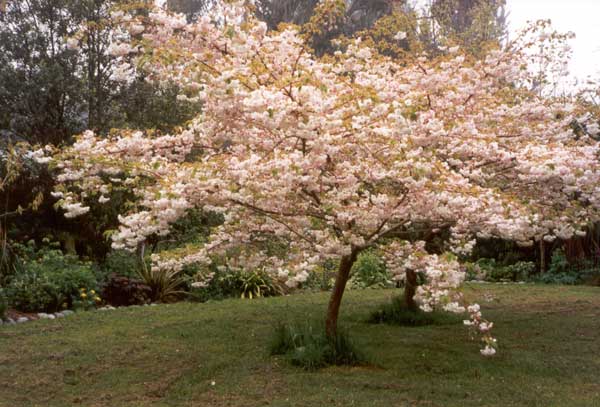Cherry Tree Biography
Basic cherry tree care consists of watering, fertilizing, pruning, and protecting against pests and diseases. Cherry trees typically have a shorter life span than other flowering trees, simply because they are more prone to diseases and pests. By performing regular maintenance, the life of the tree can be prolonged significantly.
Most varieties of cherry tree prefer moist soil. One exception, the Sergeant Cherry, can tolerate drier conditions. Until a watering pattern has been established, it is helpful to probe the soil around the tree about three inches (8 cm) deep. If the soil is dry, the tree is in need of water. Performing this action regularly will help determine how often the cherry tree should be watered.
Applying organic mulch around the base of the tree will help seal in moisture, and prevent the soil from drying out to an intolerable level. When watering, it’s best to maintain a slow trickle of water over a longer period of time, rather than pouring large amounts of water around the tree quickly. Enough water must be applied to nourish the bottom of the root system. However, overwatering can cause a cherry tree to develop root rot.
Pruning a cherry tree should be done in the spring, after all threat of frost has passed. They don’t require as much pruning as other fruit trees. However, some maintenance is required to prevent disease, and allow light and air to penetrate to the center of the tree. All broken, dead, or diseased branches should be removed, and weak or crossed branches should be trimmed lightly. Side branches can be cut back to the main branch to promote new growth.
Cuts should be made with the pruning tool about an eighth of an inch (0.3 cm) above the bud, and at an angle. Weeping cherry trees should be pruned to maintain their natural weeping shape. Sour cherry trees have a natural open growing habit and do not need pruning as frequently as sweet cherry trees. All types of cherry trees require only minimal pruning once they have fully matured.
Protecting against pests and diseases is perhaps the single most important part of cherry tree care. Birds are the greatest threat to cherries, as they can strip the tree of fruit in very little time. Netting placed over the tree in the summer months will prevent birds from stealing the fruit. Sanitizing pruning tools after use, and removing rotten wood and fruit from the ground surrounding the tree will help prevent disease.
Most varieties of cherry tree prefer moist soil. One exception, the Sergeant Cherry, can tolerate drier conditions. Until a watering pattern has been established, it is helpful to probe the soil around the tree about three inches (8 cm) deep. If the soil is dry, the tree is in need of water. Performing this action regularly will help determine how often the cherry tree should be watered.
Applying organic mulch around the base of the tree will help seal in moisture, and prevent the soil from drying out to an intolerable level. When watering, it’s best to maintain a slow trickle of water over a longer period of time, rather than pouring large amounts of water around the tree quickly. Enough water must be applied to nourish the bottom of the root system. However, overwatering can cause a cherry tree to develop root rot.
Pruning a cherry tree should be done in the spring, after all threat of frost has passed. They don’t require as much pruning as other fruit trees. However, some maintenance is required to prevent disease, and allow light and air to penetrate to the center of the tree. All broken, dead, or diseased branches should be removed, and weak or crossed branches should be trimmed lightly. Side branches can be cut back to the main branch to promote new growth.
Cuts should be made with the pruning tool about an eighth of an inch (0.3 cm) above the bud, and at an angle. Weeping cherry trees should be pruned to maintain their natural weeping shape. Sour cherry trees have a natural open growing habit and do not need pruning as frequently as sweet cherry trees. All types of cherry trees require only minimal pruning once they have fully matured.
Protecting against pests and diseases is perhaps the single most important part of cherry tree care. Birds are the greatest threat to cherries, as they can strip the tree of fruit in very little time. Netting placed over the tree in the summer months will prevent birds from stealing the fruit. Sanitizing pruning tools after use, and removing rotten wood and fruit from the ground surrounding the tree will help prevent disease.
Cherry Tree
Cherry Tree
Cherry Tree
Cherry Tree
Cherry Tree
Cherry Tree
Cherry Tree
Cherry Tree
Planting A Cherry Tree
Cherry Tree Pruning








No comments:
Post a Comment